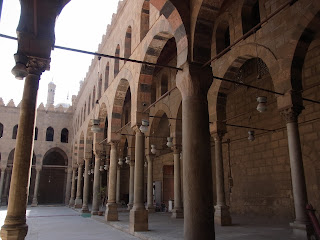All right, let's kick off our shoes and roll. No. 1 is the Kalawoun, a rectangular block with a marble-columned courtyard at the Citadel fortress overlooking Cairo. Looks kinda militaristic from the outside.
It has two minarets whose bases are below roof level, which is unheard of in these parts. Two views of the stately courtyard:
A fat minaret. I'm newish to Islamic architecture, but it seems that one way of dating mosques is by judging how much mass their towers have. As building techniques improved, they got skinnier. As always, corrections welcomed.
Not sure if the coloring on these voussoirs is a thousand years old, but in this climate, why not?
Detailing on the qibla side, orienting the faithful toward Mecca.
Mosque No. 2, the Mohammad Ali, dominates Cairo's southeastern skyline. It's a baby, finished around the time of the American Civil War. With its half-domes, it's trying to recapture the imperial Ottoman style I became familiar with in Istanbul. Not all that significant in the scheme of things, but a good place to get out of the sun.
Mosque No. 3, and the most significant, is Al-Azhar, a few miles away in Islamic Cairo. It's not that people are "more" Islamic in this part of town, but there is a rhythm to life here that probably isn't that much different than it was hundreds of years ago. Yet there are plenty of cafes in this square, almost like a City Hall area you'd find in Europe.
Still, the area seems way conservative. I love how Cairo throws you these curveballs.
The approach to Al-Azhar. It's in the Fatimid style, from the 10th century.
Al-Qairah (Cairo) was new when this place was established. Before that, the population center was in Memphis, now long gone, to the west.
The courtyard. Note that the arches are keel-shaped, not semicircular. (This also may be a handy dating tool.) The more you look at Islamic architecture, the more there is to learn and admire. Same with anything, I guess.
I dive into the prayer hall and find about 150 prostrate men waiting out the daylight hours. It's an odd sensation. I want to take lots of pictures of the interior and never feel unwelcome, but I'm in my stocking feet, stepping around bodies, trying not to walk in front of anyone praying, etc. Very cool, but weird for a visitor with a bellyful of food and water in the waning hours of Ramadan.
The reason I say this may be the most important institution in all of Islam is that it established a university in 980 A.D. and remains the world's pre-eminent center of Sunni learning. Eight-and-a-half out of 10 Muslims are Sunni, and, well, I did the math.

















Sounds like you've learned a lot about the architecture. The lights in the baby mosque are interesting; are they as low-hanging as they look?
ReplyDeleteYes. It would be hazardous tossing a Frisbee, for instance.
ReplyDelete